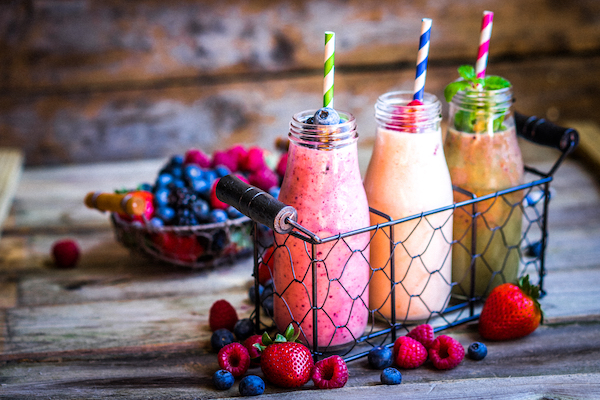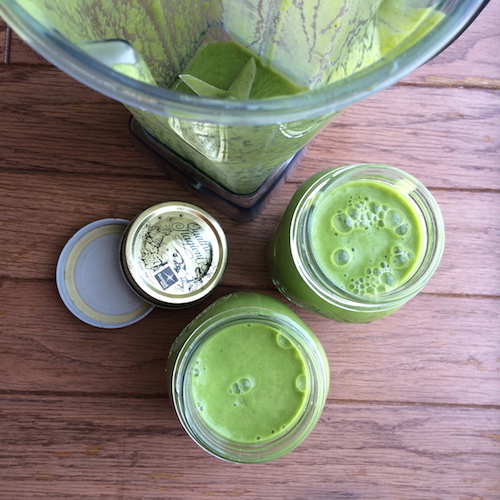Smoothie How-To Guide: “Smoothie 101”
By Alexandra Fiman Maul, MPHPublished: April 7, 2015

A re you a smoothie-lover? Or, maybe you’re new to the world of blending? Smoothies are an easy way to get your fruit and veggie servings each day. They are convenient, on-the-go meals or snacks, and they taste great! In this Smoothie How-to Guide, I’ll walk you through the benefits of blending up frozen concoctions and how to make the best smoothies, including tips to make them part of your daily routine.
What are the health benefits of smoothies?
Smoothies are loaded with vitamins, minerals, phytonutrients, amino acids, antioxidants, fiber, protein, and more! All of these nutrients you’re drinking are essential to feeling your best. From radiant skin to improved digestive health, drinking your fruits and veggies every day is an easy way to give your body what it needs to glow. Talk about plant power!
Bonus: Because you blend up whole fruits and vegetables in the smoothies, you take advantage of all of that filling fiber. Fiber can improve elimination – it helps to keep things moving – and contributes to feeling full. Try replacing your usual breakfast muffin or bagel with a fiber and protein-packed smoothie. You’ll power up your day with a healthy, lower-calorie option to provide energy and sustenance. By filling up on the good stuff (fruits, veggies, nuts/seeds, yogurts, and more), you won’t have as much room left for the bad stuff (less junk). I encourage clients to throw in nuts or nut butters, seeds, oats, steamed pumpkin or squash, or clean protein powders to add more protein and fiber.
What’s the difference between juicing and blending? Is one better for you than the other?
Remember that fiber I talked about above? Well, when you juice your fruits and vegetables using a juicer or masticator, you’re only using the juice from the produce (here’s an example). The fiber is extracted by the juicer and dumped out as pulp, which you can reuse. Because your body doesn’t have to work to digest the fiber, the nutrients may get into your bloodstream quicker. And, removing the fiber means you can add more vegetables and fruits into a jam-packed juice than you could into a smoothie.
Alternatively, when you blend your produce, you keep your ingredients whole, so you retain the fiber, which helps to sweep toxins through your digestive track and improve bowel habits. The fiber also helps to regulate your blood sugar and may keep you feeling full and satiated longer.
Both juicing and blending have terrific healthful benefits, so try them both! Always consult your doctor if you have any questions about how they will affect your body, or if you have any chronic conditions.
What kinds of things do you put in a smoothie?
Smoothies can be as simple as ice, liquid (like water, milk, or coconut water), and fruit (or better yet, veggies) – see a sample recipe below.
Great fruit options include:
- banana
- mango
- pineapple
- papaya (paw paw) (click here for a papaya smoothie recipe)
- grapes
- citrus
- avocado
- apple
- pear
- berries
Fabulous veggie choices include:
- leafy greens, like spinach, kale, chard, and baby lettuce
- herbs, like mint, basil, parsley, and cilantro (click here for a minty mango smoothie)
- squash, sweet potato, and pumpkin (click here for a pumpkin smoothie recipe)
- beets or carrots and their green tops
Optional add-ins:
- nuts and nut butters (almonds/almond butter, cashews/cashew butter, peanuts/peanut butters, and more)
- seeds and seed butters (hemp, sunflower, chia, flax)
- dried fruit
- oats or quinoa (cooked)
- spices and roots (ginger, cinnamon, nutmeg, turmeric, vanilla extract)
- yogurt
So you may be asking yourself, do I put vegetables in smoothies?
The answer is yes! Green smoothies, or smoothies that have leafy greens or vegetables added to them, are such an easy, delicious way to add more nutrition in your diet. They not only taste great, I promise, but they add so many wonderful nutrients.
Greens, like spinach (perfect for blending newbies), kale, chard, romaine, and lettuce, work well. Or try cucumber, herbs, or celery. Even if you’re not a veggie-lover, delicious smoothies are a super easy way to increase your veggie intake. Don’t worry, it won’t taste like you’re eating a salad, but you’ll be getting just as many awesome benefits! My husband, who always gave me strange looks when I’d blend up green drinks, went from zero greens to adding small amounts of spinach to now being a huge green smoothie fan. If he can do it, so can you!
Pineapple Delight Smoothie for Beginners
1 cup or 1 handful of washed fresh spinach
½ cup of chopped fresh or frozen pineapple
1 peeled fresh or frozen, spotted banana, cut into chunks
1 cup of water
Ice**
**If you use frozen fruit, you’ll get a creamier texture without having to add ice! If you do use frozen fruit, increase your liquid until you get the texture you desire. A handy tip: when your bananas start to get spotty, peel them, cut into chunks, and freeze so they’re ready anytime!
Add the liquid and greens to your blender, add the fruit, and blend until smooth.
My favorite part about smoothies, besides the fact they’re such an easy way to get increase your fruit and vegetable servings, is that you can blend whatever sounds good to you that day. Feeling adventurous? Make the smoothie above, but add in coconut milk, half of a cucumber, or a couple of sprigs of mint! I’m a huge fan of experimenting to find your favorite ingredient combos.
Like what you're reading? Sign up for our free newsletter and never miss a post! Plus get a FREE digital version of our Issue No.10 with sign up.

- Smoothie How-To Guide: “Smoothie 101” - April 7, 2015
- Smoothie How-To Guide: Where Do I Start? - April 7, 2015
- Smoothie How-To Guide: Ingredients, Extra Add-ins, And Blenders - April 21, 2015













